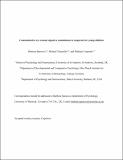Files in this item
Communicative eye contact signals a commitment to cooperate for young children
Item metadata
| dc.contributor.author | Siposova, Barbora | |
| dc.contributor.author | Tomasello, Michael | |
| dc.contributor.author | Carpenter, Malinda | |
| dc.date.accessioned | 2019-06-27T23:41:23Z | |
| dc.date.available | 2019-06-27T23:41:23Z | |
| dc.date.issued | 2018-10 | |
| dc.identifier | 253450911 | |
| dc.identifier | 3a5448e4-4b0d-4420-9caf-3476839216f7 | |
| dc.identifier | 85049093245 | |
| dc.identifier | 000442704800016 | |
| dc.identifier.citation | Siposova , B , Tomasello , M & Carpenter , M 2018 , ' Communicative eye contact signals a commitment to cooperate for young children ' , Cognition , vol. 179 , pp. 192-201 . https://doi.org/10.1016/j.cognition.2018.06.010 | en |
| dc.identifier.issn | 0010-0277 | |
| dc.identifier.other | ORCID: /0000-0003-3983-2034/work/64698023 | |
| dc.identifier.uri | https://hdl.handle.net/10023/17998 | |
| dc.description.abstract | Making commitments to cooperate facilitates cooperation. There is a long-standing theoretical debate about how promissory obligations come into existence, and whether linguistic acts (such as saying “I promise”) are a necessary part of the process. To inform this debate we experimentally investigated whether even minimal, nonverbal behavior can be taken as a commitment to cooperate, as long as it is communicative. Five- to 7-year-old children played a Stag Hunt coordination game in which they needed to decide whether to cooperate or play individually. During the decision-making phase, children’s partner made either ostensive, communicative eye contact or looked non-communicatively at them. In Study 1 we found that communicative looks produced an expectation of collaboration in children. In Study 2 we found that children in the communicative look condition normatively protested when their partner did not cooperate, thus showing an understanding of the communicative looks as a commitment to cooperate. This is the first experimental evidence, in adults or children, that in the right context, communicative, but not non-communicative, looks can signal a commitment. | |
| dc.format.extent | 1312847 | |
| dc.language.iso | eng | |
| dc.relation.ispartof | Cognition | en |
| dc.subject | Communicative eye contact | en |
| dc.subject | Commitment | en |
| dc.subject | Nonverbal communication | en |
| dc.subject | Cooperation | en |
| dc.subject | Coordination | en |
| dc.subject | Stag hunt game | en |
| dc.subject | BF Psychology | en |
| dc.subject | NDAS | en |
| dc.subject | BDC | en |
| dc.subject | R2C | en |
| dc.subject.lcc | BF | en |
| dc.title | Communicative eye contact signals a commitment to cooperate for young children | en |
| dc.type | Journal article | en |
| dc.contributor.institution | University of St Andrews. School of Psychology and Neuroscience | en |
| dc.contributor.institution | University of St Andrews. Centre for Social Learning & Cognitive Evolution | en |
| dc.identifier.doi | https://doi.org/10.1016/j.cognition.2018.06.010 | |
| dc.description.status | Peer reviewed | en |
| dc.date.embargoedUntil | 2019-06-28 |
This item appears in the following Collection(s)
Items in the St Andrews Research Repository are protected by copyright, with all rights reserved, unless otherwise indicated.

